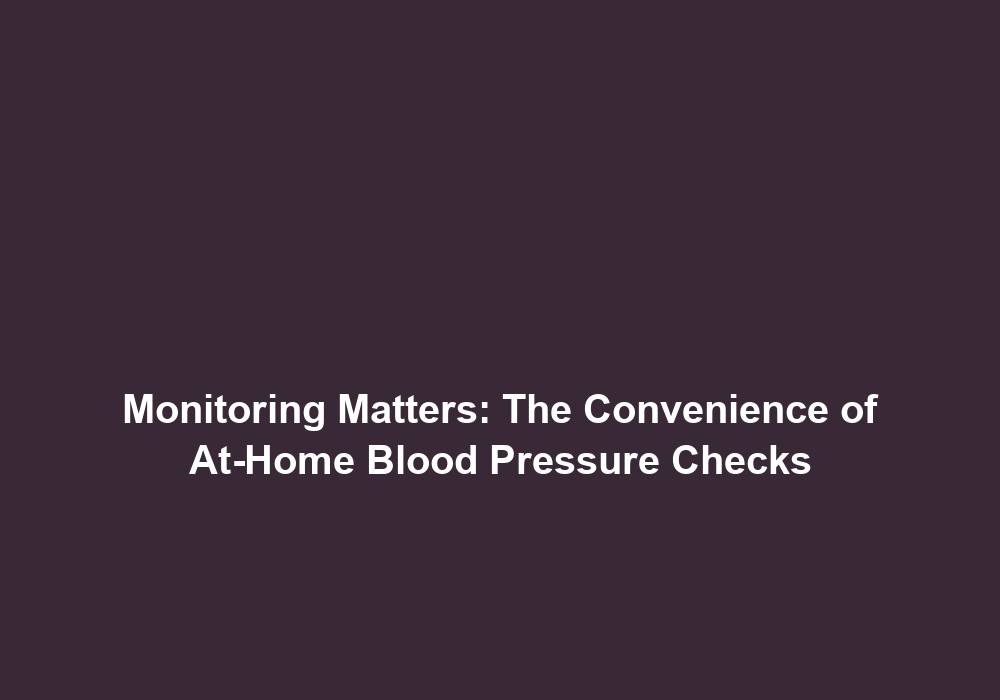Monitoring Matters: The Convenience of At-Home Blood Pressure Checks
As technology continues to advance, more people are taking a proactive approach to their health, seeking convenient ways to monitor their well-being. One crucial aspect of health is blood pressure, and keeping it in check is essential for maintaining overall well-being. In the past, visiting a doctor’s office was the primary way to measure blood pressure accurately. However, with the advent of at-home blood pressure checks, individuals can now conveniently monitor their blood pressure from the comfort of their own homes. This article delves into the convenience and benefits of at-home blood pressure checks, highlighting why monitoring matters.
The Rising Importance of Blood Pressure Monitoring
High blood pressure, also known as hypertension, is a prevalent health condition that affects millions of people worldwide. It is often referred to as a silent killer because it typically shows no symptoms until it leads to severe complications such as heart disease, stroke, or kidney problems. Regular monitoring of blood pressure levels helps individuals detect potential issues early on, enabling them to take the necessary steps to maintain a healthy lifestyle and seek medical intervention if required.
Monitoring blood pressure is crucial for several reasons:
-
Early Detection of Potential Issues: Regular blood pressure monitoring allows individuals to catch any abnormalities or fluctuations early on. By identifying these issues, individuals can take appropriate actions to prevent further complications. For example, if someone notices consistently high blood pressure readings, they can adjust their diet, exercise routine, or seek medical advice to manage the condition and reduce the risk of heart disease or stroke.
-
Prevention of Major Health Complications: High blood pressure is a significant risk factor for various health problems, including heart disease, stroke, and kidney disease. By monitoring blood pressure regularly, individuals can identify any significant changes and take proactive measures to prevent these complications. For instance, if someone notices a sudden increase in blood pressure, they can consult with their healthcare provider to adjust their medication or lifestyle habits to bring it back to a healthy range.
-
Motivation for Lifestyle Changes: Monitoring blood pressure at home provides individuals with tangible data on how their lifestyle choices impact their readings. This knowledge can serve as motivation for making positive changes, such as adopting a healthier diet, increasing physical activity, or managing stress levels. Regular monitoring allows individuals to track their progress and see the positive impact of their efforts on their blood pressure levels.
The Convenience of At-Home Blood Pressure Checks
- Comfort and Privacy: At-home blood pressure checks provide a level of comfort and privacy that is not always possible during a traditional doctor’s visit. Many individuals feel more relaxed and at ease when taking readings in the familiar environment of their own homes. This comfort can result in more accurate measurements as anxiety or stress from medical settings can potentially influence blood pressure readings.
Moreover, privacy is crucial when it comes to health-related matters. Some individuals may feel uncomfortable discussing sensitive health information in a clinical setting. By conducting blood pressure checks at home, individuals can maintain their privacy and have a sense of control over their health data.
- Time-Saving: Visiting a doctor’s office often involves waiting times, scheduling appointments, and dealing with traffic. At-home blood pressure checks eliminate these inconveniences, allowing individuals to monitor their blood pressure at their preferred time and without any hassle. This time-saving aspect is particularly beneficial for individuals with busy schedules or those who live in remote areas where access to medical facilities may be limited.
Additionally, at-home blood pressure checks save time in the long run by reducing the need for frequent doctor’s appointments solely for blood pressure monitoring. Individuals can keep track of their readings regularly without disrupting their daily routines.
- Cost-Effective: Regular medical check-ups can be expensive, especially if one needs to monitor blood pressure frequently. At-home blood pressure checks provide a cost-effective solution, as the initial investment in a reliable blood pressure monitor is often more affordable than multiple doctor’s visits. Additionally, repeated at-home monitoring can help identify potential issues early on, preventing more significant health complications that may require costly medical interventions.
Moreover, by monitoring blood pressure at home, individuals can potentially catch any abnormalities before they become severe, reducing the need for costly hospitalizations or emergency interventions.
- Empowerment through Self-Care: At-home blood pressure checks empower individuals to take an active role in managing their health. By monitoring their blood pressure regularly, individuals can gain a better understanding of how their lifestyle choices, such as diet, exercise, and stress management, affect their blood pressure levels. This knowledge enables them to make informed decisions and take appropriate steps to maintain optimal blood pressure levels.
Furthermore, self-monitoring encourages individuals to engage in self-care practices and take responsibility for their health. By actively participating in their own well-being, individuals can develop healthy habits that contribute to long-term blood pressure management.
- Enhanced Communication with Healthcare Providers: At-home blood pressure checks provide individuals with a comprehensive record of their blood pressure readings over time. This data can be valuable during doctor’s visits, as it enables better communication with healthcare providers. By sharing these records, individuals can collaborate with their doctors to develop tailored treatment plans, monitor the effectiveness of medications or lifestyle changes, and make informed decisions about their overall health.
Sharing blood pressure readings with healthcare providers allows them to assess the effectiveness of current treatments, make necessary adjustments, or provide additional guidance. It fosters a more collaborative and informed approach to managing blood pressure.
Choosing the Right Blood Pressure Monitor
When considering at-home blood pressure checks, it is crucial to select a reliable and accurate blood pressure monitor. Here are some essential factors to consider while choosing a monitor:
-
Accuracy: Look for a blood pressure monitor that has been validated for accuracy by reputable organizations or regulatory bodies. Accuracy is vital to ensure reliable readings and prevent any false sense of security or unnecessary alarm.
-
Cuff Size: Ensure that the blood pressure monitor comes with a cuff size appropriate for your arm circumference. An ill-fitting cuff can lead to inaccurate measurements. Most blood pressure monitors offer different cuff sizes, so select one that fits comfortably and snugly around your upper arm.
-
Ease of Use: Opt for a blood pressure monitor that is user-friendly and comes with clear instructions. Features such as large, easy-to-read displays and intuitive controls make it easier to obtain accurate readings consistently.
-
Memory and Connectivity: Consider a blood pressure monitor that has built-in memory or the ability to connect to a smartphone or computer. Having a record of your blood pressure readings can be valuable for tracking trends over time and sharing data with healthcare providers.
By carefully considering these factors, individuals can choose a blood pressure monitor that suits their specific needs and ensures accurate readings.
How to Use an At-Home Blood Pressure Monitor
To ensure accurate blood pressure measurements, follow these steps:
-
Prepare: Find a quiet, comfortable space where you can sit and relax for a few minutes. Avoid any activities that may raise your blood pressure, such as caffeine consumption or smoking, for at least 30 minutes before taking a measurement.
-
Positioning: Sit with your back straight and feet flat on the floor. Rest your arm on a flat surface, such as a table, with your palm facing up. Place the cuff around your upper arm, ensuring it aligns with your heart level.
-
Taking the Measurement: Turn on the blood pressure monitor and follow the device-specific instructions. Generally, you will need to press a button to start the measurement. Remain still, avoid talking or moving during the process. Once the measurement is complete, the monitor will display your systolic (top number) and diastolic (bottom number) blood pressure readings.
-
Record and Interpret: Note down the readings along with the date and time. Over time, you can observe patterns and trends in your blood pressure levels. If you have any concerns or if your readings consistently indicate high or low blood pressure, consult with your healthcare provider for appropriate guidance and further evaluation.
Following these steps ensures consistent and accurate blood pressure measurements, providing individuals with reliable information for managing their health.
Conclusion
Monitoring blood pressure is vital for maintaining overall health and well-being. At-home blood pressure checks offer convenience, comfort, and cost-effectiveness, empowering individuals to take control of their health. By choosing the right blood pressure monitor and following proper measurement techniques, individuals can monitor their blood pressure accurately, detect potential issues early on, and collaborate effectively with healthcare providers. With monitoring matters, prioritize your health and make at-home blood pressure checks a part of your routine for a healthier future.
Note: This article is generated using OpenAI’s GPT-3 language model. While the information provided is based on general knowledge and research, it is always advisable to consult with healthcare professionals for personalized advice and medical guidance.







